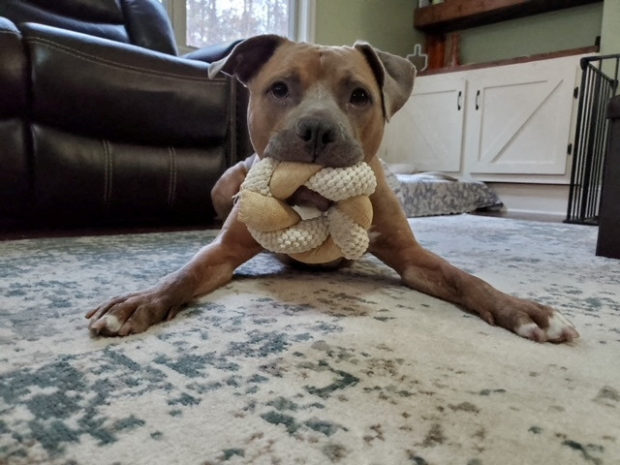High Anxiety: How to handle the cost of a stressed-out dog

Odin, a seven-year-old American Pitbull Terrier, looks on, at an unknown location in this undated image. Arielle Carey/Handout via REUTERS
NEW YORK — Arielle Carey has a seven-year-old neutered male American pitbull terrier named Odin who is sweet as pie at home in Atlanta – that is…until Odin gets freaked out by people and dogs he does not know.
When Carey’s former community in South Carolina did not allow privacy fencing, she moved back to Georgia. It was not a cheap journey: the move plus additional training totaled in the thousands of dollars.
The effort was worth it, though. “He’s so much calmer and more relaxed now,” Carey says.
Odin is not the exception – he is the norm. In fact, 57% of dog owners report that their furry family members are anxious, according to a new Dog Anxiety Awareness Survey performed by research firm Kantar Group on behalf of CEVA Animal Health.
And that can come with a big price tag. Owners of anxious dogs report spending $400 more a year on care – on a variety of different issues like vet visits plus Puppy Prozac.
Pet anxiety seems to have increased since the pandemic, especially as people return to the workplace and routines get disrupted, says Kristen Levine, a pet expert, creator of the “Pet Living” blog (kristenlevine.com) and co-author of the book “Pampered Pets on a Budget.”
In an era when many people are living paycheck to paycheck, and inflation is driving up costs, added petcare bills can feel like a punch in the stomach.
The percentage of dog owners who report using some kind of calming product for their pet – such as a toy, treat, or collar – more than doubled in two years, to 51% in 2020, according to the National Pet Owners Survey from the American Pet Products Association.
The most common stressors for dogs? Noise (40%), separation anxiety (33%) and what is called ‘reactivity,’ such as seeing deer in the yard or encountering another dog (15%).
A few of the most-claimed health pet conditions include gastrointestinal issues, diarrhea, skin conditions and vomiting, all of which “could very well be caused by anxiety,” according to North American Pet Health Insurance Association spokesperson Samantha Bell.
Different interventions can help – some behavioral, some medicinal. Here are ways to manage anxiety-related costs:
Catch them early
Once you identify triggers – fireworks, doorbells or losing it whenever you leave the house – taking early action will not only improve your dog’s quality of life, but save money over the long term.
If the condition progresses to something “severe,” reported by 21% of dog owners, then it will likely only get more costly – including the destruction of property.
Consider meds
In some cases medication might be an appropriate response. When a former dog of Levine’s, a Dalmatian mix named Chilly, had a phobia of thunderstorms, an oral gel called SILEO helped, at a cost of around $40 a month. And another pooch, who suffered from severe separation anxiety, was helped by Trazodone at around the same monthly cost.
Nineteen percent of owners are even considering CBD products as a possible solution to relax their dogs, according to the National Pet Owners Survey.
Behavior modification
Sometimes smaller fixes can do the trick. Consider an ‘anxiety wrap,’ a calming vest which applies pressure like weighted blankets do for humans.
Experts also recommend pheromone diffusers, which retail online for around $25. Pheromone diffusers work kind of like those plug-in air fresheners, distributing chemicals into the air that are known to soothe pets.
Many pet parents use a crate to keep dogs secure and calm jitters – as Arielle Carey did with Odin. Or if dogs are stressed out by something like thunder, playing recorded sounds on low volume while doing something enjoyable – like playing a game or getting treats – can change negative associations.
Get covered
Pet insurance helps with some expenditures. Like humans, policies will be more affordable if you take them out at a younger age.
Do your due diligence about what a policy addresses and what it does not. Standard dog training expenses might not be covered, although interventions prescribed by veterinary behaviorists likely will, says Levine. An expert consult will typically cost in the range of $250-300.
Most important, do not hope that your dog’s anxiety issues will magically disappear.
“If the pet is acting in any way that is destructive to either itself or its environment, something needs to be done,” says Dr. Jerry Klein, chief veterinary officer for the American Kennel Club. “The cost of veterinary care, replacement of objects ruined, as well as possible litigious concerns, more than justifies asking your veterinarian for recommendations that are amenable to you and your family’s budget.”
RELATED STORIES
From goats and cows to alpacas, meet the latest stress-busting therapy animals
‘Firecrackers can cause trauma in animals’
‘Ambassadogs’ offer stress relief to UP students during ‘hell week’
Residents rescue horses, farm animals left on volcano island